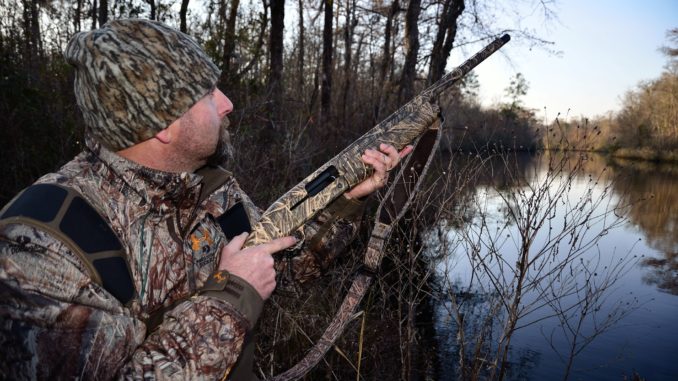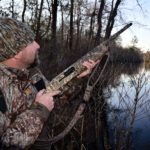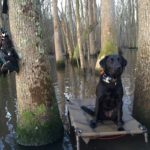
Big waterfowl migration begins earlier than most hunters think; plenty of ducks, including native woodies, will be in Carolina waters this month.
Fall is a difficult seasons for outdoorsmen because of all the available options, including hungry speckled trout, hormone-crazed bucks, speedy doves and smoking king mackerel. But a true sportsman in the Carolinas wouldn’t be in the groove if a trip to flooded timber or a beaver pond for wood ducks didn’t show up on the November agenda.
Duck hunting is one of the South most-honored traditions. In the Carolinas, a youngster’s first waterfowl hunt is usually in a swamp somewhere. While it wouldn’t be uncommon for a teal or mallard to show up, the whistling woody is usually the first blood in the South’s flooded forests.
Most waterfowl species spend the summer in the breeding grounds of Canada and the northernmost portions of the United States. Wood ducks are one of the few ducks known to reside year-round in the Carolinas, earning them, long ago, the nickname “summer ducks.” They prefer forested wetlands over inundated marsh and open-water; the Carolinas offer woodies a nearly endless supply of the nesting, foraging and breeding habitats they prefer. But while many wood ducks nest here and raise their young, they are still migratory birds, and a high percentage departs on a migratory journey like their relatives.
According to Dean Harrigal, waterfowl coordinator for the S.C. Department of Natural Resources, the Carolinas have two populations of wood ducks.
“We have wood ducks that raise here and wood ducks that we receive,” said Harrigal. “Some of the local ducks may spend their entire life cycle here, but a lot of them disperse to adjoining states during the fall migration.”
Through banding programs, Harrigal observes band returns from South Carolina ducks in other states and from other states bands collected in South Carolina.
“Typically, our banded woodies show up in North Carolina, South Carolina, Georgia and Alabama, but our hunters kill wood ducks in South Carolina that were banded in the New England states and southern Ontario,” Harrigal said. “By the time hunting season arrives, we get a mixture of homegrown and migrants, but there are a lot more migrants here than most people realize.”
Wood ducks are very adaptable and can go about anywhere when the temperatures begin to fall and the days get shorter. As November arrives, the waterfowl migrations are in full swing across the northern hemisphere and the wood ducks are filling up the Carolina’s flooded forests and beaver ponds with a vengeance.
“Combine the shorter days, cold temperatures, and a full moon in early November, you will get a wave of birds on the move,” said Harrigal, whose South Carolina hunters have a Nov. 19-26 season to which they can look forward.
As wood ducks arrive, they gravitate towards flooded regions where trees and forested cover is available.
“Wood ducks prefer forested wetland habitats and beaver ponds where some of the trees are still alive. As opposed to open-water puddle ducks that loaf in the middle of a pond, wood ducks hide in the edges of trees,” Harrigal said.
Clark Purvis of North Carolina’s Roanoke River Waterfowl hunts in the lower Roanoke River delta, where 88,000 acres of public, flooded timber provides excellent wintering habitat for incoming and resident wood ducks.
“The Roanoke River Wildlife Refuge is the largest intact bottomland forest east of the Mississippi,” said Purvis (252-826-4288). “It is why wood ducks and other puddle ducks flourish here. These forests are loaded down with pin oaks. They were eating acorns thousands of years ago. Never underestimate the power of the pin oak. I have seen wood ducks walk as far as 50 yards on the bank to eat acorns.”
Purvis has fantastic hunts during North Carolina’s Nov. 12-Dec. 3 season, after the first wave of migratory birds has arrived. While he gets his three-bird limit of woodies on just about every trip, he will hunt open areas next to wooded banks to take advantage of the six-duck limit with mallards, green winged teal, and other puddle ducks.
“Wood ducks can be tough to hunt in the flooded swamps, because they don’t come into small holes as well as mallards do,” Purvis said.
Wood ducks will search the swamps and look for a stable food source, normally along shallow banks where cover is abundant and plenty of acorns are available. However, they develop routine flight paths from roosting areas to solid food sources. A normal routine is any wild animal’s downfall and a distinct advantage for a hunter. Wood ducks are easy to pattern, especially during the early morning flights away from the roost.
“The best way to target wood ducks specifically is to know the flight patterns and get in those lanes to get good constant shooting. I really like the open parts of creeks on a long straightaway,” Purvis said.
Ducks are known to travel using natural landmarks — the run of a creek or a swamp edge — to move from place to place. With a little scouting, travel routes can be easily detected.
Wood ducks are suckers for flooded agriculture fields, plus impounded standing corn or sorghum. The corn and sorghum itself provides both a high-energy source and sufficient cover, exactly what wood ducks yearn for during the migration. And Purvis has found another wood duck magnet.
“Wood ducks love a flooded soybean field. We have a few soybean fields that flood naturally, and we leave the soybeans standing in there to provide food and cover for them,” he said.
While the U.S. Fish and Wildlife Service gives hunters a 60-day season on the Eastern Flyway, most waterfowl hunters look at January as prime time. But November and December offer great opportunities. If cold weather hasn’t pushed a lot of migrating waterfowl south, at least resident flocks can keep the gun barrel hot.







Be the first to comment